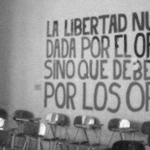May 16, the Romani Resistance continues
On May 16th, 1944, the Roma prisoners from Camp BIIe of Auschwitz-Birkenau valiantly stood up against the Nazi SS army in a great revolt that will be remembered in history as one of the sturdiest and more energetic of those produced in the infamous Auschwitz Concentration and Extermination Camps, in Nazi-occupied Poland during the Second World War.
Those Roma, armed themselves with stones, sticks, and tools to defend the lives of their own in the face of the attack of the racist system that sought to exterminate them in the gas chambers that same night. Despite the fatigue and weakness of those prisoners, of being immensely inferior in number and military power than their oppressors, the dignity and radical love for the life of the thousands of Roma held in the Roma Family Camp, Zigeunerfamilienlager, pushed back the plans of the SS for one more time. To justify and strengthen anti-Gypsyism, a false and fraudulent image of the Roma People has been intentionally built, as a community of resigned and fatalistic people who surrender themselves to their own death passively. Nothing could be further from the reality. The Roma became fiercely involved in the resistance against Nazism from the beginning, giving their lives in the anti-fascist and anti-racist cause.
But the Porrajmos / Samudaripen, the Roma Holocaust during the Second World War, is not a strange historical exception, but a sad example of the Western desire to exterminate our People. On July 30, 1749, the Spanish authorities, under the command of the Marquis of Ensenada together with the Bishop Vázquez de Tablada and the monarch Fernando VI, have set in a military motion of operation to kidnap all the Cale of the Kingdom, by separating them of each other and imprison them forever with the main intention to exterminate them: “The prison must be on the same day and in the same hour (…) These people who call themselves Gitanos have no religion; they will be indoctrinated in prison and such evil race will be ended. “
This episode in the history of the Spanish State is sadly unknown, not only by the society in general but also by many of our people. Like in Auschwitz, the resistance of our Roma ancestors in light of their imminent extermination was fierce. This is shown by the stories that testify to the courage of the Calís confined in the “Casa de la Misericordia in Zaragoza”, or the Calós from the “Carraca, in Cádiz”. The Marquis of the Ensenada enjoys an extraordinary historical consideration that does not do justice to the reality experienced by the Roma People. Many streets, institutes, and schools are named after him. Perhaps, the most humiliating example of this is that the street of the main access to the two highest organs of the Spanish Justice, the Supreme Court and the General Council of the Judicial Power, is a street that bears the name of the genocidal.
Our obligation, as Roma, is to honor the memory of our ancestors and combat the complicit silence. Anti-Gypsyism is not history; it is a reality with real effects on the lives of our people across the length and breadth of Europe. It is time to take a greater impulse and loudly denounce, to uncover together, the impunity of the powerful Gadjés. It is time to point out, if possible, with more force, the injustices that we face in schools, high-schools, tribunals, in our neighborhoods, in prisons, in the face of police violence. The silence is over!
May you have a bad rest, Gadjo de la Ensenada!





